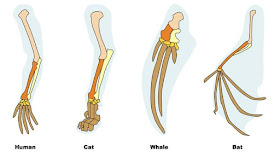It’s the same in all the vertebrates. Why that particular arrangement of bones? They’re all inherited from a common ancestor. In technical terms, those bones are homologous.
I was thinking about homology after writing this answer on Quora to the question, “What is the most fascinating thing you know about in the field of neuroscience?” Here’s my reply, inspired by my 2008 paper::
You can identify neurons that are older than dinosaurs.
Not the actual live neurons in an individual, of course, but types of neuron has been inherited for hundreds of millions of years.
Shrimp, crayfish, clawed lobster all have giant neurons that they use to perform escape movements, called lateral and medial giant neurons.
Now, this little guy is Anaspides:
It has lateral and medial giant neurons, too, and it uses them to perform escape movements.
While some call this species a shrimp, it isn’t a shrimp like most people are familiar with. The shrimps and prawns most people know are decapod crustaceans, and Anaspides isn’t a decapod. (This is why you don’t use common names for scientific purposes.) The oldest decapod fossil is about 350 million years old, so these escape related giant neurons must be older than that.
I think it’s awesome that you can identify neurons in species that are separated by at least 350 million years of evolution. It makes me appreciate deep time.
After writing this answer, Namnezia pointed out that ion channels are even older. Ion channels are molecules, and it struck me:
We talk about homologous organs, like the arm bones I mentioned above, all the time in biology.
We talk about homologous molecules, mainly sequences of DNA and the proteins they make, all the time.
But the escape neuron answer I gave above may be a little unusual because I am talking about single, identifiable cells as homologous. It struck me as interesting that we routinely talk about homology in levels of organization above cells, and below cells. But outside of identified neurons in neurobiology (and invertebrate neurobiology at that), people rarely talk about homology at the level of single cells.
The only other examples of cells that people called homologous were few. You can talk about homologous cells in C. elegans and other nematode worms, because those small animals have predetermined cell fates in development, and we can map every single cell.
Is the cellular or tissue level of organization different from molecules or organs in terms of our ability to identify distinct homologs? Or have we just not looked closely enough?
Reference
Faulkes Z. 2008. Turning loss into opportunity: The key deletion of an escape circuit in decapod crustaceans. Brain, Behavior and Evolution 72(4): 251-261. http://dx.doi.org/10.1159
/000171488
Picture from Anaspides, a Living Fossil



No comments:
Post a Comment
Comments are moderated. Real names and pseudonyms are welcome. Anonymous comments are not and will be removed.